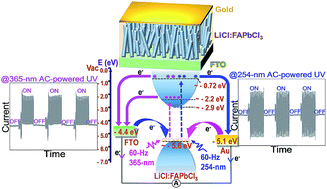Energy-distinguishable bipolar UV photoelectron injection from LiCl-promoted FAPbCl3 perovskite nanorods†
Abstract
High-performance optoelectronic devices, such as solar cells and light-emitting diodes, have been fabricated with lead halide perovskites owing to their superior carrier properties. However, charge transport in such optoelectronics is intrinsically directional due to the existence of p–n junctions, which thus lacks the potential to elucidate any perturbations in light or electricity during energy conversion. Here, with the presence of a LiCl additive in a formamidinium chloride (FACl) solution, the as-grown LiCl:FAPbCl3 nanorods demonstrate greatly enhanced crystallinity and UV photoresponse as compared to pristine FAPbCl3 nanostructures without the LiCl additive. Most importantly, the LiCl:FAPbCl3 nanorod film exhibits unprecedented distinguishability to UV photons with different energies and oscillating intensities, in the form of bipolar and periodically oscillatory photocurrents. This work could advance the fundamental understanding of photoinduced carrier processes in halide perovskites and facilitate the development of novel UV-based optical communications.



 Please wait while we load your content...
Please wait while we load your content...
